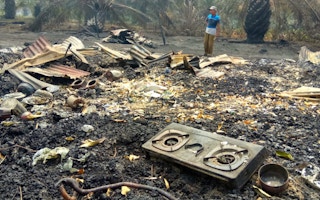Three years after forest fires in Indonesia sent huge volumes of smoke billowing into Malaysia and Singapore, the Southeast Asian neighbors are dealing with a repeat of the “embarrassing” transboundary haze problem.
This year’s dry season is expected to be particularly harsh, after a relatively mild interlude since the 2015 fires and haze, due to an El Niño pattern. Indonesia has seen a surge in fires, with 42,740 hectares (105,600 acres) of land burned across the country — double the amount of land burned at this same point last year, and spanning an area two-thirds the size of Singapore.
The worst of the fires are in Riau province, on the island of Sumatra, which is experiencing its second dry season of the year. The fires there have razed 27,683 hectares (68,400 acres) since the start of the year, according to data from the Ministry of Environment and Forestry Ministry. The Peatland Restoration Agency (BRG), established by Indonesia’s president in the wake of the 2015 fires to prevent the burning of peat forests, says there are indications the fires this year have been set by commercial concession holders rather than smallholder farmers, given their scale and spread.
The resulting haze from the fires has for several days now blanketed large swaths of Riau, including its capital, Pekanbaru. Winds have also spread some of the haze across the Malacca Strait to Malaysia.
“
Although the 2019 dry season is shaping up to be more serious than last year, some fire prevention measures on the ground have not been maintained — for example, canal blocks intended to keep peatland wet and fire-resistant have fallen into disrepair.
Simon Tay, chair, Singapore Institute of International Affairs
Affected regions there include Kuala Lumpur, Selangor, Putrajaya, Negri Sembilan and Penang, according to the Malaysian Meteorological Department (MetMalaysia).
“The haze is caused by a moderate amount of smog moving from hotspots in the central and southern parts of Sumatra due to the Southwest Monsoon winds,” MetMalaysia director-general Jailan Simon said as quoted by The Star newspaper.
He said Malaysians would continue to suffer from haze “as long as there are hotspots in Sumatra” due to wind patterns.
Singapore is also bracing for haze in the coming days, and has begun issuing its first daily haze advisories of the year. Singapore Foreign Minister Vivian Balakrishnan said in a statement during a recent meeting with his Southeast Asian counterparts that while he noted that there had been relatively no transboundary haze pollution in the last three years in the region, “it remained worrying that the total number of hotspots this year had exceeded that of the same period last year.”
“Although good progress had been made in combating transboundary haze pollution, Minister Balakrishnan stressed the need to maintain efforts on that front,” the statement added.
Preventive measures
The haze from the 2015 fires stoked a diplomatic row between Indonesia and its neighbors, with Vice President Jusuf Kalla criticising Singapore and Malaysia for complaining about the haze and asking them to be grateful instead for the clean air they enjoyed the rest of the year.
But the burning also prompted a raft of policies from President Joko Widodo aimed at preventing future fires, in particular by restoring and conserving peat forests. Draining of these forests’ carbon-rich soil is one of the first steps to clearing the land for planting, but it also renders the peat layer highly combustible.
The BRG, also born of these new policies, is in charge of overseeing efforts to block the drainage canals and rewet peatlands. It has also drilled nearly 12,000 wells to provide easily accessible water for firefighting efforts as of 2018.
It’s not enough, however, simply to build the infrastructure, says Simon Tay, chair of the Singapore Institute of International Affairs (SIIA), a think tank.
“Although the 2019 dry season is shaping up to be more serious than last year, some fire prevention measures on the ground have not been maintained — for example, canal blocks intended to keep peatland wet and fire-resistant have fallen into disrepair,” he said.
Pantau Gambut, a coalition of 23 local NGOs that monitor peat protection and restoration efforts, also found through that peat-rewetting and firefighting infrastructure in some areas weren’t functioning properly. One village in Jambi province, adjacent to Riau, was found to have fire hoses that were too large for the available water pressure, and too short to reach fire-prone areas. A water pump installed in another village in Jambi wasn’t powerful enough to provide sufficient water to put out fires.
BRG chief Nazir Foead acknowledged that canal-blocking infrastructure built in the past three years needed to be checked again. “Indeed, the construction of canal blocks hasn’t reached all areas that are prone to fires,” he said. “Furthermore, since 2016 we’ve been prioritising local people to build canal blocks, instead of big contractors, of course using simple technology that can be mastered by the locals.”
This year, the agency is allocating 10 per cent of its construction budget on maintaining existing infrastructure, Nazir said. He added the agency had detected peatlands drying out at worrying rates in regions vulnerable to peat fires.
“At the end of May, the water level in peatlands detected by our monitoring stations started to decline, approaching 0.4 meters [16 inches] below the surface,” he said.
To keep peat soils resistant to fire, the water level has to be maintained at or above that level, he said. Any lower and the peat will catch fire easily; once that happens, the fire will be difficult to extinguish, Nazir said.
As of July, the average water level at 90 locations monitored by the BRG had dropped below that critical threshold, with peatlands in Riau particularly very dry in the first three weeks of July. In Riau’s Indragiri Hilir district, the water level at some points had dropped to 1.2 meters (47 inches) below ground level.
This story was published with permission from Mongabay.com. Read the full story.

















